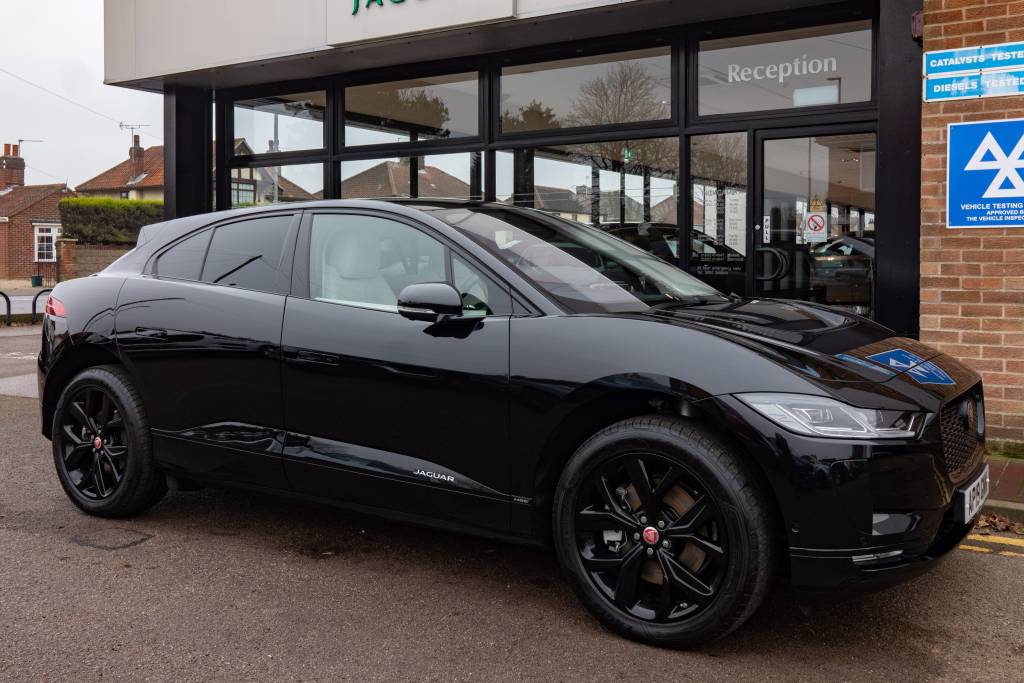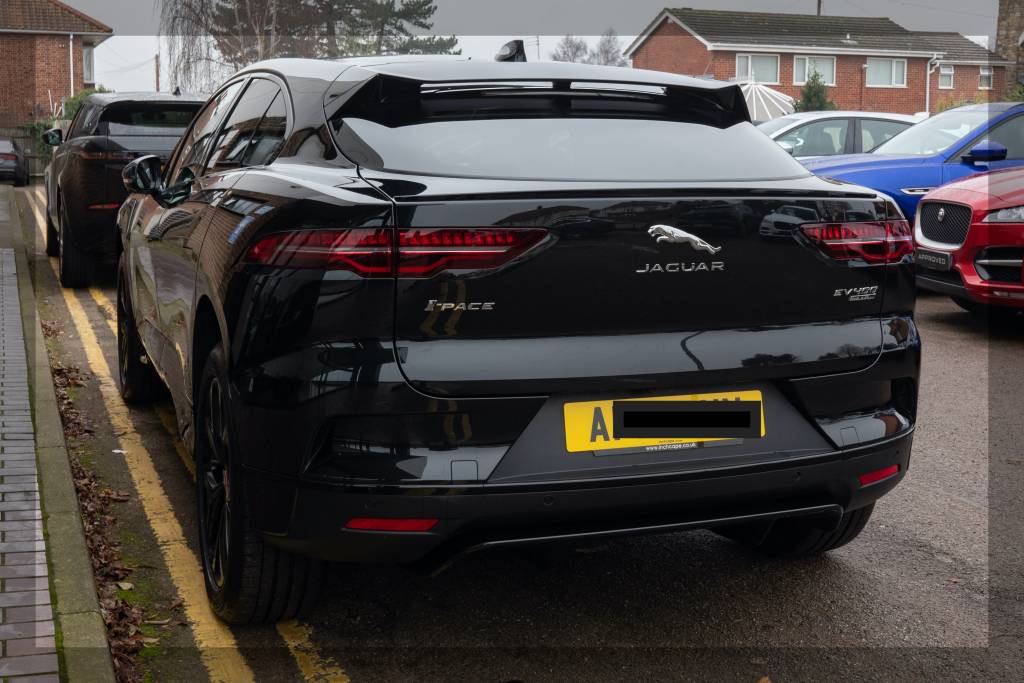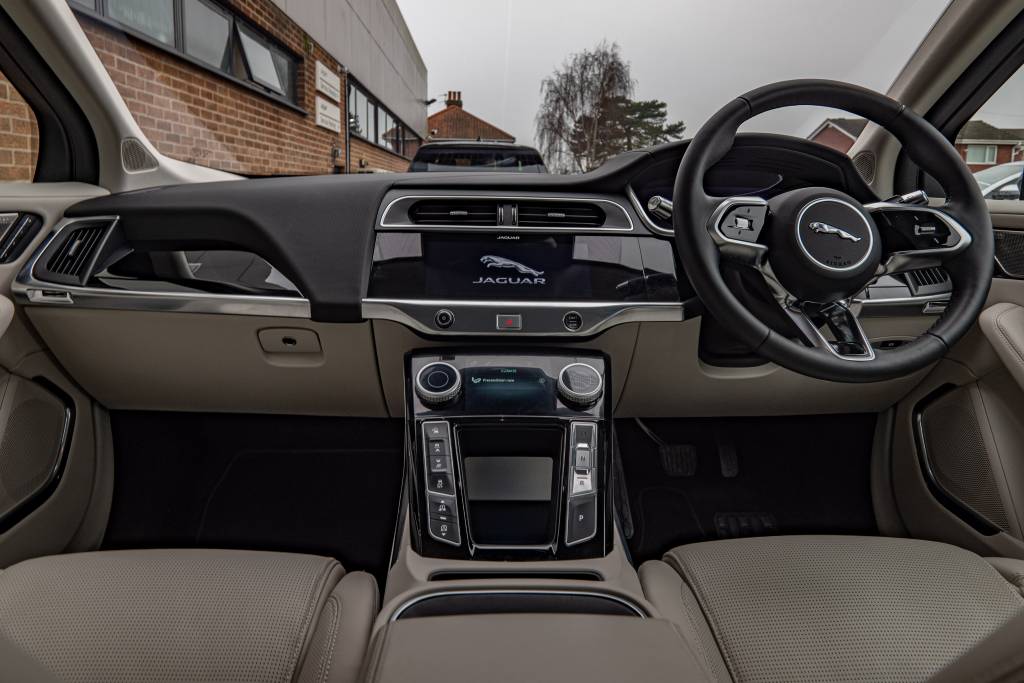First encounter with the Jaguar Monochrom
Now for something completely different, not photo-centric for once. But I hope you will bear with me and don’t get too bored, as I embark on my electric highway. There is an increasing interest in electric traction and all the world’s major manufacturers are being dragged, somewhat reluctantly, to the party table. The more electric cars they sell, the lower their penalties for producing polluting vehicles. So the investment in electric traction isn’t altogether altruistic.

I like electric cars. My first encounter was five years ago when I took part in an 18-month Government-sponsored survey on behalf of the automotive and electricity industries. The task was to get up to ten cars — the Nissan Leaf in this case — charging regularly in one area, or, to be more precise, though one electricity substation.
As it happened, the local substation soon creaked. It had to be rebuilt before we could charge. I did say it was an experiment.
Range angst
But once the juice came through to power my 7.2KWh home charger pod, I settled down to an enjoyable time with the Leaf. Its big problem was range, rated then at a rather optimistic 85 miles. I really took to that little car and would certainly have kept it had it not been for the abysmal range.
This was ok for pootling around town, but a longer trip required serious planning. The range was wholly inadequate. As any EV owner will tell you, range angst sets in at least 30 miles from zero; so the Nissan’s effective range was nearer fifty miles than eighty. There’s none of this running the tank down to empty and knowing that you still have about 20 miles in reserve to find a filling station. And finding that filling station is much easier than wheedling out a vacant charging point. Needles and haystacks spring to mind.
Since 2015, things have improved dramatically, with Tesla in the forefront both in the range of its cars and the admirable network of “filling stations”. Is it time to rethink? Perhaps a Tesla?

For the past two years, I’ve been behind the wheel of a diesel SUV, now four years old. A lovely car, but tainted by the war on diesel and subject to more rapid depreciation than you would expect from the marque. With a new low-emission zone coming to my area in 2021, I could soon be subject to a daily charge (albeit resident discounted) for using my own car. Time for a change.
Shingleton approach
For the past couple of months, I have been boring John Shingleton in Australia with my quest for a replacement car. John, like me, is interested in cars. His thing, as you know, is old Porsches but, after a lifetime in the motor industry, he knows a thing or two about the automotive industry.
Should I get a petrol version of the same Macan, I asked, or go radical with a fully electric vehicle? I was time for a decision and I’m glad to say I’ve now made it. The Macan went to a local dealer, my friends at Porsche Brooklands (reliable buyers of used Porsches), and I set about the quest for an EV. I’d already been questing for several months, so I had a pretty good idea what I wanted.
I test drove both the Tesla Model 3 and Model S. Both were nice, without wishing to damn with faint praise. But the fit and finish, even of the new Model 3, were inferior to those on my old car. Significantly so, I should add. Somehow, I felt I would be disappointed once he charm had worn off. Tesla has mastered the technology and created a magnificent recharge network; but, somehow along the way, it doesn’t quite match the quality achieved by traditional premium manufacturers.
The Model 3 was the one I considered most, but I really doubted whether I could ever become accustomed to the paucity of controls, the complete absence of a central instrument cluster and total reliance on a dash-mounted iPad.

The speedometer display in the top right-hand corner of the central screen (and well off-centre to the driving position), was something I felt I could not get to like. I could be wrong about this. Perhaps if I’d bought one I would soon become accustomed and I would be singing its praises.
Thoughts turned to alternatives and the only serious contender in the same market segment in my book is Jaguar’s I-Pace. I thought it might be nice to have a British car (although I know, it’s actually made in Austria, but it is a traditional Coventry brand) for a change, and it does look the business. After a road test or two (the acceleration is, as with every electric car I’ve tried), I decided that if I went to an EV it should be the Jaguar.
Fast forward several weeks and thousands of key clicks between London and New South Wales (where John had spied his first I-Pace in the wild for the first time and loved the visual impact), I made the decision. I bought a nine-month-old I-Pace from Inchcape Jaguar in Norwich and it will be sitting in front of my house shortly. It is my ideal specification but hardly my choice of colour. I would have preferred something lighter, although I do like the off-white interior. Maybe I will call it my Jaguar Monochrom.
225 miles: Is it enough?
I already know I will enjoy driving it and I will get used to the limitations of the range. Officially, it is rated at 298 miles (485km) but that is generated in Cloud Cuckoo Lane (or, as the Germans charmingly put it, das Wolkenkuckucksheim). From what I’ve seen and read, this boils down to a real-world range of around 225 miles (around 370km) and those miles have to be driven in pretty ideal conditions — for an electric vehicle, that is. However, my friend Ralf Meier, the train enthusiast in Washington, DC, has had an identical car outside his home for the past nine months. He’s delighted with what he calls “the cat” and hasn’t suffered a smidgeon of range angst so far. His enthusiasm, and John’s liking for the design, have been largely responsible for my decision.

Unlike petrol or diesel cars, electrics love stop-start city driving and hate fast roads with constant speeds and no chance of a bit of regenerative braking. And, paradoxically, it is on faster journeys where you need more range, not when driving locally because you are always within easy range of your home charging pod.
I’ve played with Jaguar’s range calculator and, to get anywhere near the advertised 298 miles you have to drive around town at glacial speeds, doing lots of regenerative braking, in an I-Pace with no heating or airconditioning and shod with 18in wheels. I like my creature comforts, I don’t spend much time in city traffic and my new car has 20-in wheels. That’s a bad point and knocks about 8% from the range.
None the less, for 95% of my driving, within a 100-mile radius of London, the Jaguar’s range should be more than adequate. And an added bonus is that I can actually drive into the city without paying the £11.50 “congestion charge”. I can even visit Red Dot Cameras in Goswell Road with no charge. I might even be able to park for free if I find a vacant charger.
But I will undoubtedly encounter range angst, as I would with any electric car. Longer journeys definitely need planning. Fortunately, I live in a densely populated country where it isn’t too difficult to find charging points, assuming they are not already occupied for a tedious hour by one of the other converts to electric traction. In John’s case, I suspect, the I-Pace would be impractical for other than local journeys.
Owning an electric car definitely won’t all be smooth cruising, however. Apart from Tesla’s excellent (and exclusive) network, the rest of the electric cars on the road share a haphazard ragbag of proprietary chargers and their owners need to subscribe to endless providers. I already have four or five cards and apps to help ease the pain. It is less than ideal, as I found five years ago with the Leaf. And things can only have become worse as additional charging points are overtaken by the ever-increasing numbers of electric cars on the road.
Experiment
Electric cars are in the news and will occupy more and more column inches. So I am looking forward to the experiment as much as anything else. I have taken this step as much for the experiment as for my liking for electric traction. Can I really live with an electric car? Or will I find longer journeys a pain in the 18-way memory seats?
There’s only one way to find out and I am intending to share my experiences with you because, after all, we are all sooner or later going to have to change over to electric. Whether or not you can cope depends very much on your journey pattern and, indeed, where you live. I have little doubt that had I been undertaking long journeys regularly, I would have been forced into Tesla’s arms rather than Jaguar’s. But let’s find out.
I’m looking forward to sharing my thoughts, both on the I-Pace itself and on the challenges of the electric infrastructure, over the next year or two. At least it will give me some opportunities to take photographs along the way.

Looking forward to this series! I’ll be curious to read the European experience of an EV.
I have a Tesla Model 3 and I agree with your sentiment on fit and finish. I’m fine with the car as is, but I’ve had to have a few things fixed after purchase that should not have been. They are selling a lot and I think they’re rushing them out.And I’ve had one or two bugs/glitches, thankfully not while driving. I’ve learned to not run the AC or heater much of the time because it just uses battery; I honestly don’t mind, preferring fresh air anyway.
Still, I love it!!! So much better than a gas-powered car, which now feels clunky. Beyond any carbon-emissions avoidance, they are super duper fun to drive. We researched and the M3 fits our tall family of 4 plus luggage and has good range. Teslas are everywhere here in California, as are many other EVs, but not that many I-Pace’s (I’ve seen one so far). We also have a Subaru Outback as our long-distance travel and mountain car, and all-around hauler.
This is a experiment for us. I consider myself a beta tester. EVs will evolve and improve, and may even prove to not be the savior we might be looking for, to reduce emissions. In California, with an unreliable power grid (freakin PG&E!!!) they might be a liability too. But I don’t mind change and I’m willing to participate in this great experiment.
Looking forward to your own experiment.
Andrew. I agree entirely with you in this. I have a nagging suspicion I ought to have bought a Model 3 if only for the charging infrastructure. But I reasoned that my use of the public chargers will be infrequent and I might as well get the car that I prefer. I do not have a second car but we do have a good train network in this country and, frankly, I prefer to use the train for anything more than a couple of hundred miles. I can write while travelling! Only time will tell, however.
Not much fun driving from Diss to Cornwall (420 miles) . . or indeed last year’s skiing trip where I have a vision of Tesla’s at the side of the road all the way up the Isere valley!
. . . and there aren’t any 4 seat convertibles (sad old me, but I’ve driven those since my first Saab Convertible in 1989.
Bah
Agreed. Each to his own. I suspect that most I-Paces and Teslas are owned as a second car, primarily for use around town. While I don’t do many journeys such as you describe, I know that having an electric car means I can’t contemplate them. It remains to be seen whether or not I can live with this, but the next twelve months will make it break. At least it’s a Monochrom.
I would like the acceleration of electric which ironically would mean a lot less range! I think we are still in the early adopter phase and I also do not want to be constantly fretting over planning my next charge. I also do not want to drift in for maintenance and discover that I need room on my visa for a replacement of thousands of dollars of batteries. The one advantage I see is there is a lot more opportunity to go take pictures instead of killing time while waiting for the car to charge:)
Two aspects here, Brian. You are quite right that spirited driving means low mileage — and how. Other factors, as I think I said, are just as important. Having 20in wheels instead of 18in reduces the range by 10 miles, believe it or not (even though the rolling circumference is identical) and, of course, heating and airconditioning have a big impact. And the type of journey matters a lot. EVs are at their best around town on short journeys — in direct contrast to IC vehicles. They at their thirstiest at constant highway speeds, which is where we really need the range. So, in answer to my question in the headline, EVs are probably not yet ready for prime time. When we get 100+ KWh chargers (as Tesla already offer) my car will charge fully in 40 minutes and that’s a lot more like it.
As for batteries, most cars come with the sort of guarantee that ensures that early adopters won’t be needing a fresh set of batteries. Jaguar warrants the system for 8 years and, since I seldom keep a car for more than two years, that’s ok for me. The big problems will come further down the line as values plummet. This is where the fun will start.
As you point out Mike the elephant in the room is the charging infrastructure that will be required. For the few Tesla’s on the road today it’s supportable, but if we all drove electric cars we would bring the current electric transmission and generating systems to their knees. The cost to build the new generation facilities, upgrade or add to the existing distribution networks, and add the charging points on every street, is not something any of our governments want to tackle, particularly when the time comes to announce the tax increases to fund it all.
There are solutions to some of the problems: faster charging rates during off-peak hours, local storage batteries that are trickle charged 24/7, requiring every new house and building to have a built in storage battery that back-feeds the system, but all these options cost money and will not be popular with tax payers. The next 20 years will be interesting for our politicians, yet the changes must be made.
Agreed. With my home 7.2KWh charger (when I get the cable swapped to Type 2 Mennekes) the car will charge overnight in eight hours. So I will never leave home without a full tank. It’s on longer journeys, relatively infrequent in my case, that the problem arises. We have a situation where Tesla has cracked it — I seldom see a bank of Tesla chargers fully occupied. It’s the rest of the industry that needs to catch up. With two main standard plugs for rapid charging (CHADdeMo and CSS), it’s pot luck what you find. And there aren’t as many of them as there are for Tesla. I think I am in for an interesting time.
I’ve ridden in Jaguar I-Pace taxis in Munich and in Paris, and they’re quiet, comfortable ..well, more than quiet: SILENT.. and with a high viewpoint (which I like, because, as a driver, I cannot BEAR other people’s ******* headlights in my eyes!) so I think you’ll really like your I-Pace, Mike.
Far from a clanking electric milk float, it seems comfy, civilised, quick ..but there’ll always be that nagging “where will I be able to get a quick charge?” at the back of my mind till the range goes up to 500 miles.
But new, more efficient batteries are on their way, although sticking newer ones in an old(er) car doesn’t seem to be quite feasible ..yet.
Thanks, David. I have a sequel on the way, outlining my disastrous (in traffic terms) first drive home from Norwich yesterday. The car came through with flying colours, but I was down to 60 miles “in the tank” when I got home. Today I’ve been out charging because my home charger still has the old Nissan Leaf cable and I have to wait until February 5 to get it changed. I got up to 80% and now I’m trickle charging through the domestic 13-amp plug. We are fortunate that we have 240 volts and can charge the car this way in “only” 30 hours. In the USA, unless you install a 240-volt circuit, that time must be much longer. So far so good and, you are right, this is a wonderful car with some gadgets that are right up my alley.
Can you not use a commercial transformer from your 13amp socket to step up from the domestic supply to a three phase output? As I used to do with three phase power items?
I don’t want an electric car at the moment – 225 miles means another miserable hour to get to Whitby from where I live. That’s on top of the some times seven hour drive I already endure. Perhaps when they hit 400 mile range it will be a deal I can live with.
Not exactly sure what you mean here, but the car comes with a cable and charger pod which connects to a 13-amp socket. My car is charging at the moment, but the rate is very slow — around 30 hours from completely empty to full. But overnight it will put on 30% of a charge. The 7Kwh home charger (which I have but currently has an incompatible cable) will charge the car in about 8 hours, so there is little chance of ever leaving home without a full charge.
I honestly believe that the only cohort to derive any advantage from this sort of vehicle is the builder, who no longer has to concern himself with complex mechanical construction and fluid dynamics.
Who needs all that, when you can just install an off the shelf supplied induction motor on each corner, each with about three moving parts, and then a pc in the middle to program its safety features.
Either that or I suspect that a company like Tesla might well end up not as a car manufacturer but rather as a motor and battery manufacturer for the traditional industry like Jaguar, BMW etc. to buy off the shelf products from and then add their value.
Kerching!
And what is more, any pollution has just reversed back up the line a bit, it hasn’t gone away.
I agree, Stephen. My motivation in choosing an electric car is not to save the planet. I fully realise that, while EVs are kind for cities, they simply push the pollution elsewhere. In particular, used batteries currently go into landfill, so that’s storing up major long-term problems. I am mainly interested in EVs because they are fun to drive and because I like tech. It’s also good to be a Good Guy, ready to take advantage of cheaper parking, no congestion or pollution charges and, eventually, motorway lane priority. But also it’s the way forward, so I might as well get used to it. I probably will not get an IC car again, provided I don’t have major charging problems. However, I have to resign myself to foregoing Continental gallops as in the past. No more London to Wetzlar, or wherever, in one day. Having to stop for an hour every 150 miles to recharge would be a real deal-breaker.